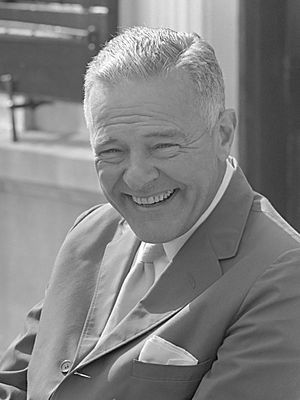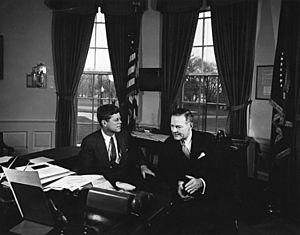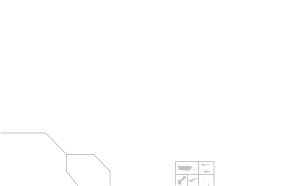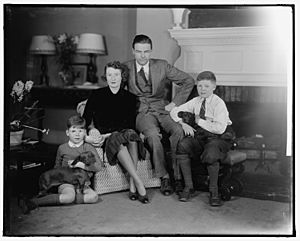Henry Cabot Lodge Jr. facts for kids
Quick facts for kids
Henry Cabot Lodge Jr.
|
|
|---|---|

Lodge in 1964
|
|
| Personal Representative of the President to the Holy See | |
| In office June 5, 1970 – July 6, 1977 |
|
| President | Richard Nixon Gerald Ford Jimmy Carter |
| Pope | Paul VI |
| Preceded by | Harold Tittmann (Acting) |
| Succeeded by | David Walters |
| United States Ambassador to West Germany | |
| In office May 27, 1968 – January 14, 1969 |
|
| President | Lyndon B. Johnson |
| Preceded by | George C. McGhee |
| Succeeded by | Kenneth Rush |
| United States Ambassador to South Vietnam | |
| In office August 25, 1965 – April 25, 1967 |
|
| President | Lyndon B. Johnson |
| Preceded by | Maxwell D. Taylor |
| Succeeded by | Ellsworth Bunker |
| In office August 26, 1963 – June 28, 1964 |
|
| President | John F. Kennedy Lyndon B. Johnson |
| Preceded by | Frederick Nolting |
| Succeeded by | Maxwell D. Taylor |
| 3rd United States Ambassador to the United Nations | |
| In office January 26, 1953 – September 3, 1960 |
|
| President | Dwight D. Eisenhower |
| Preceded by | Warren Austin |
| Succeeded by | Jerry Wadsworth |
| United States Senator from Massachusetts |
|
| In office January 3, 1947 – January 3, 1953 |
|
| Preceded by | David I. Walsh |
| Succeeded by | John F. Kennedy |
| In office January 3, 1937 – February 3, 1944 |
|
| Preceded by | Marcus A. Coolidge |
| Succeeded by | Sinclair Weeks |
| Member of the Massachusetts House of Representatives from the 15th Essex district |
|
| In office 1932–1936 |
|
| Preceded by | Herbert Wilson Porter |
| Succeeded by | Russell P. Brown |
| Personal details | |
| Born | July 5, 1902 Nahant, Massachusetts, U.S. |
| Died | February 27, 1985 (aged 82) Beverly, Massachusetts, U.S. |
| Political party | Republican |
| Spouse |
Emily Sears
(m. 1926) |
| Children | George C. Lodge II Henry Sears Lodge |
| Parents | George Cabot Lodge I Mathilda Frelinghuysen Davis |
| Relatives | Lodge family |
| Education | Harvard University (BA) |
| Military service | |
| Allegiance | |
| Branch/service | |
| Rank | |
| Battles/wars | World War II |
Henry Cabot Lodge Jr. (born July 5, 1902 – died February 27, 1985) was an American diplomat and politician. He was a member of the Republican Party. He represented Massachusetts in the United States Senate. He also served as the United States Ambassador to the United Nations under President Dwight D. Eisenhower.
In 1960, he ran for Vice President with Richard Nixon. They lost closely to John F. Kennedy and Lyndon B. Johnson. Lodge later worked as a diplomat for presidents Kennedy, Johnson, Nixon, and Ford. He was also a presidential candidate in 1964.
Lodge was born in Nahant, Massachusetts. His grandfather was Senator Henry Cabot Lodge. He graduated from Harvard University. He then won election to the Massachusetts House of Representatives. In 1936, he became a U.S. Senator for Massachusetts. He left the Senate in 1944 to serve in World War II in Italy and France. He stayed in the Army Reserve after the war, becoming a major general. In 1946, he returned to the Senate.
He helped convince Dwight D. Eisenhower to run for president in 1952. Lodge managed Eisenhower's campaign, helping him win the Republican nomination. Eisenhower won the election, but Lodge lost his own Senate re-election to John F. Kennedy. In 1953, Lodge became the United States Ambassador to the United Nations. He later led the U.S. team that signed the Paris Peace Accords, which ended the Vietnam War. He passed away in Beverly, Massachusetts, in 1985.
Contents
Early Life and Career
Henry Cabot Lodge Jr. was born in Nahant, Massachusetts. His father was George Cabot Lodge, a poet. His grandfather, also named Henry Cabot Lodge, was a famous Senator. His family had a long history of public service.
Lodge went to St. Albans School and Middlesex School. In 1924, he graduated from Harvard College. After college, he worked in the newspaper business until 1931. In 1932, he was elected to the Massachusetts House of Representatives. He served there until 1936.
Serving in the U.S. Senate and World War II
In November 1936, Lodge was elected to the United States Senate as a Republican. He served from January 1937 to February 1944.
World War II Service
Lodge served bravely in World War II. He became a lieutenant colonel. He had two tours of duty during the war. The first was in 1942 while he was still a Senator. He was a major in the 1st Armored Division. He led American tanks in battle, being among the first Americans to fight German troops on land.
In February 1944, he resigned from the Senate to return to active duty. He was the first U.S. Senator to do this since the Civil War. He saw action in Italy and France. In 1944, he captured a four-man German patrol by himself.
After the war, he used his knowledge of French to help coordinate with French forces. He also helped with surrender talks with German forces in Austria. Lodge received several awards for his service. These included the French Legion of Honour and Croix de Guerre. His American awards included the Legion of Merit and the Bronze Star Medal.
After the war, Lodge returned to Massachusetts. He continued to be an Army Reserve officer and eventually became a major general.
Return to the Senate and Eisenhower's Campaign
In 1946, Lodge was elected back to the Senate. He became a voice for the moderate wing of the Republican Party. He believed that America should work with other countries to keep peace. He felt that World War II showed the importance of countries working together.
In 1951, Lodge helped convince General Dwight D. Eisenhower to run for president. Lodge managed Eisenhower's campaign. He played a key role in helping Eisenhower win the Republican nomination. Eisenhower won the general election in 1952.
1952 Senate Campaign
In 1952, Lodge ran for re-election to the Senate. His opponent was John F. Kennedy, who was then a U.S. Representative. Lodge was very busy helping Eisenhower's presidential campaign. This meant he could not focus as much on his own race. In November 1952, Lodge lost to Kennedy.
Ambassador to the United Nations (1953–1960)
In February 1953, President Eisenhower appointed Lodge as the U.S. ambassador to the United Nations. His position was made part of the President's Cabinet. Lodge strongly supported the UN as a way to promote peace. He served for seven and a half years, a record for a U.S. Ambassador to the UN.
During the Cold War, Lodge often debated with Soviet Union representatives at the UN. He was known for speaking firmly to them on television. In 1959, he escorted Soviet leader Nikita Khrushchev on a well-known tour of the United States. In 1960, Lodge visited the Soviet Union.
1960 Vice Presidential Campaign
Lodge left his role as UN ambassador in 1960. He became the running mate for Richard Nixon in the 1960 U.S. presidential election. They ran for Vice President against John F. Kennedy and Lyndon B. Johnson. Nixon chose Lodge because of his foreign policy experience at the UN. However, Nixon and Lodge lost the election by a very small margin.
Between 1961 and 1962, Lodge was the first director-general of the Atlantic Institute. This organization worked to promote cooperation between countries on both sides of the Atlantic Ocean.
Ambassador to South Vietnam (1963–1964, 1965–1967)
President John F. Kennedy appointed Lodge as Ambassador to South Vietnam in 1963. He served in this role until 1964. At this time, South Vietnam was facing many challenges. The country's leader, President Ngô Đình Diệm, was struggling to unite his people.
Lodge believed that President Diem's government was not working well. He felt that South Vietnam needed changes to succeed against the Viet Cong. Lodge supported the idea of a change in leadership in South Vietnam. He believed this was necessary for the country's future.
After Diem's government was overthrown in November 1963, South Vietnam experienced many changes in leadership. This made the country unstable. Lodge suggested that the U.S. might need to take a stronger role to bring stability. He warned that without stability, the U.S. might need to get more involved militarily or leave South Vietnam entirely.
In June 1964, Lodge resigned as ambassador. He decided to run for the Republican presidential nomination in the 1964 election.
1964 Presidential Candidacy
In 1964, while still Ambassador to South Vietnam, Lodge won the New Hampshire primary as a surprise "write-in" candidate. This meant people wrote his name on the ballot even though he wasn't officially running. His campaign was organized by a small group of volunteers. This victory made many people, including the press and Republican leaders, consider him a serious candidate.
However, Lodge chose not to become an open candidate. He did not do as well in later primary elections. The nomination eventually went to Barry Goldwater.
Later Diplomatic Career
President Lyndon B. Johnson re-appointed Lodge as ambassador to South Vietnam in 1965. He served there again until 1967. After that, he worked as an Ambassador at Large from 1967 to 1968. He then became Ambassador to West Germany from 1968 to 1969.
In 1969, his former running mate, Richard Nixon, became president. President Nixon appointed Lodge to lead the American team at the Paris peace negotiations. These talks aimed to end the Vietnam War. From 1970 to 1977, Lodge also served as a special representative for the President to the Holy See (the government of the Catholic Church).
Personal Life
In 1926, Henry Cabot Lodge Jr. married Emily Esther Sears. They had two sons: George Cabot Lodge II (born 1927) and Henry Sears Lodge (1930-2017). George became a professor at Harvard Business School.
Henry Sears Lodge Jr., M.D. (1958-2017), Henry's grandson, was a doctor. He became known for writing the 'Younger Next Year' series of books.
In 1966, Lodge was made an honorary member of the Massachusetts Society of the Cincinnati.
Henry Cabot Lodge Jr. passed away in 1985 after a long illness. He was buried in the Mount Auburn Cemetery in Watertown, Massachusetts.
Images for kids
See also
 In Spanish: Henry Cabot Lodge Jr. para niños
In Spanish: Henry Cabot Lodge Jr. para niños
- List of United States political appointments that crossed party lines








